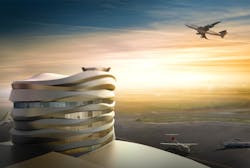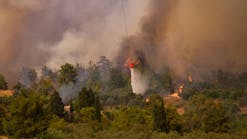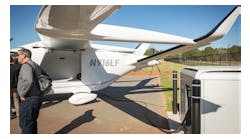When Jordan Cicoria’s company traveled across the world to find business opportunities in 2016, little did he know they would find a partner in making changes to how airports operate a lot closer to home.
In October, Cicoria — who is managing director of Aerium Analytics — said the company was in Japan for an aerospace show as part of an Alberta delegation, when they struck up a conversation with representatives from Edmonton International Airport (EIA) about unmanned aerial vehicles (UAVs).
EIA was showcasing the Alberta Aerospace and Technology Centre and Aerium was showcasing its drone technology. As the two entities got to talking, it led the airport to take a drastic leap forward in its operations and become one of the first airports in North America to embrace the advent of drones.
“Edmonton really embraces new technologies and really wants to be on the forefront of that,” Cicoria said. “And they really realize with UAVs and UAS that as they put it, it’s a matter of time, it’s coming and you can either try to fight it, or more importantly, you can embrace and adopt the technology.”
Aerium and Clear Flight Solutions have partnered to implement a full drone program for Edmonton in order to help optimize operations and create new ways of taking care of challenges the airport faces using quad copter and fixed wing drones to gather data on land imaging, volumetric data and surveying data.
One segment of the system is the Robird, which is a robotic bird designed to reduce bird strikes. It is designed to look and fly like a falcon to scare off birds from nesting on the site. Cicoria said it even flaps its wings for propulsion.
Falconry has been used by some airports to keep birds at bay, but Cicoria said the robotic bird is more controllable, allowing you to scare them off and heard them away from dangerous areas on the airfield.
“The whole concept here is you’re playing on the bird’s natural instincts,” he said. “With that, their natural instinct is to avoid predators.”
The Robird has been tested in Europe in the agriculture industry and at a small airport in Germany, Cicoria said, with EIA the first to adopt it in North America. The drones are now in operation.
Drones Are Ready For Airports
Miriam Hinthorn, U.S. operations manager at Consortiq, said a lot of people expected drones to be more prevalent by now in various industries across the nation, but the slow movement, isn’t about the technology but due to policies related to drones.
The aviation industry is starting to embrace the technology in airports now because revenues can be very fickle and Hinthorn said implementing a UAS for various tasks can provide a significant cost savings. Taking data accrued from UAS sensors and placing them into an IoT platform can provide airports and airlines a chance to implement predictive maintenance plans for assets.
“Normally, you’ve had to hire an inspector to look at their roof. They can cut that time and you’re probably reducing it by 70 percent by using a UAS to do it,” she said. “If you scan it 300 times in a year, you can record it and you can start to look at a rate of change on a particular shingle even, so over time, you have to do fewer and fewer inspections because you’ve got your data figured out and spending way less on maintenance overhead.”
Hinthorn said airports are not just looking at drones for maintenance inspection, but various different tasks, including security.
“Paradoxically, you use it to mitigate the risk of hobbyists flying their drones into the area if you have constant surveillance that’s really inexpensive to run at a safe distance,” she said.
Running drones on the airport require planning depending on usage. Hinthorn said if you’re running a UAS in a low-risk area, you need less redundancies and less training, and fly it higher to survey wider areas in a shorter period of time. The FAA has a maximum altitude of 400 feet for using a UAS at the airport.
Using a UAS on higher risk areas, such as runways means airports need to take more precautions and instill more training to make sure the equipment is used safely, which can get complex.
Hinthorn said people with an air control or aviation background can put together a comprehensive plan for UAS usage at an airport because all the considerations and planning can be extremely time intensive by taking into account all the different risks and weigh them to come up with something that can save the airport money while not being more trouble than it’s worth.
“You might be really limited on what you can do and maybe you have to have protocol where it’s always tethered and only someone who has like 100 flight hours can operating that drone right now since everything is still with a pilot doing everything move-by-move,” Hinthorn said. “There’s no fully automated system right now.”
There can be challenges with getting federal authorization to implement a UAS at an airport, but Hinthorn said making a case for mitigating risk, preventing fly-away incidents and what kind of training staff will have can make the case for approval. This involves creating a very robust operational handbook.
“If you have a really robust case, then you’ve clearly pressure tested your ideas, you’ve pressure tests your operational protocol,” she said. “It’s not undoable. It’s kind of a high startup cost so to speak.”
Drones Invade Atlanta
Marshall Eichfeld, mid-Atlantic unmanned aerial systems lead for Michael Baker International, said, Hartsfield-Jackson Atlanta International Airport (ATL) had interest with integrating a UAV with its project inspection workload. The airport flew a drone over a parking garage in January to inspect it, so the concept of using one on the airfield also was appealing.
There is a major construction project coming up on the airfield at ATL and Eichfeld said it created a really good opportunity to work in unmanned aerial photography as part of the project.
“What’s really nice about the unmanned aerial is that you can for fairly cheap put this up into the air and gather some photos and videos and also some orthography,” he said. “And in theory, you can quantify pavement conditions and you can take progress photos throughout a construction site.”
In order to use a drone for the project, Eichfeld said they needed to gain clearance from the Federal Aviation Administration (FAA) to operate the drone in Class B aerospace.
The idea to use a drone at ATL was first thought of in the summer of 2016, he said, but ATL was very eager to work with the firm on getting the authorization. It took about eight months to get the authorization, then Eichfeld said they were given a list of instructions from FAA on what the approval covered.
In order to fly under the authorization, Eichfeld said, it depends on what direction airplanes in flying in to land so they could shut down the runway the drone was being used on. They also want to perform the inspections when ATL is doing its regular shutdown of the runway as part of its inspections.
“Getting that Class Bravo FAA airspace authorization I think was a really big deal and a big step for the industry,” he said, “Just getting the approval from the FAA was a big milestone.”
The first drone scan of Runway 9L/27R was completed in March, with about 3,000 linear feet surveyed. The Topcon Falcon 8 drone collected 630 photos of the airfield in less than 20 minutes.
Eichfeld said they plan their missions each time the unit is flown so the data collection team knows what to expect. Sometimes they will also take video.
“You can in theory take video frames and do analysis from that,” he said.
When a drone goes up, there’s a pilot in command and a digital observer, who watch the drone the entire time help the pilot.
Eichfeld said the time it takes to do an inspection via drone can vary depending on what kind of pixel density the users are seeking or what data you’re looking for. Depending on the aircraft, they will get about 20 to 25 minutes of battery life on the drone, so on larger sections being documented; Eichfeld said they will have to change batteries during the operation.
“The top-down imagery is something that’s unique that typically you would have had to spend five figures to bring an aerial surveyor out or a helicopter possibly to shoot these shots,” he said. “Now it’s something that is relatively cheap and easy for contractors and engineers to go out and quickly look at their sites or do rudimentary calculations.”




